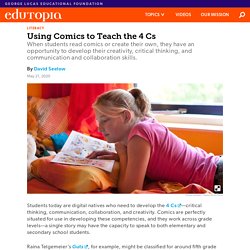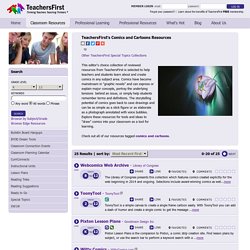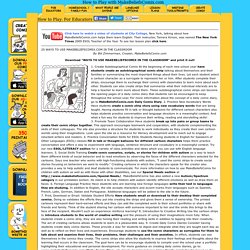

Using Comics to Teach the 4 Cs Across Grade Levels. Students today are digital natives who need to develop the 4 Cs—critical thinking, communication, collaboration, and creativity.

Comics are perfectly situated for use in developing these competencies, and they work across grade levels—a single story may have the capacity to speak to both elementary and secondary school students. Raina Telgemeier’s Guts, for example, might be classified for around fifth grade based on reading level, but this story of a girl struggling with anxiety that manifests itself in stomach ailments can reach any high school student, regardless of gender, who is trying to cope with bullying, test taking, family issues, and more. Similarly, George Takei’s They Called Us Enemy, a memoir of his childhood experience living in an internment camp for Japanese Americans during World War II, is appropriate for both fifth-grade English language arts and 11th-grade U.S.
History. Critical Thinking Communication Collaboration and Creativity. World's #1 Comic Strip Maker for Education. S Comics and Cartoons Resources. Fotor is an easy online photo editing tool that doesn't require registration.

Upload any picture from your computer to begin. Choose from the editing choices provided. Use basic editing tools to automatically enhance, rotate, crop, resize, and adjust lighting on images. Choose from many effects such as vintage, sepia, and other color effects. Add frames, apply a splash of color, or add text. Tag(s): collages (18), comics and cartoons (60), editing (80), images (277), photography (152) In the Classroom Use this tool anytime that photos need to be edited for use on class blogs, wikis, or sites. Storyboard That: The World's Best FREE Online Storyboard Creator. Draw Your Own Illustrations, Clipart & Avatars. For Educators. How to Play with MakeBeliefsComix.com How to Play: For Educators Click here to watch a video of students at City College, New York, talking about how MakeBeliefsComix.com helps them learn English.

Their instructor, Tamara Kirson, was named The New York Times 2009 ESOL Teacher of the Year. To see her lesson plan click here. By Bill Zimmerman, Creator, MakeBeliefsComix.com Download "WAYS TO USE MAKEBELIEFSCOMIX IN THE CLASSROOM" and print it out! 1. At the beginning of each new school year have students create an autobiographical comic strip talking about themselves and their families or summarizing the most important things about their lives. 2. Have students create a comic strip story using new vocabulary words that are being taught. 3.
Have students break up into pairs or group teams to create their comic strips together. Crash! Bang! Boom! How to add Google Drawings comic strips to your class. This post is co-authored by Ditch That Textbook’s Matt Miller and Cori Orlando, a teacher on special assignment (TOSA) from Simi Valley, California.

Find her blog, Leading in Limbo, at leadinginlimbo.weebly.com. We (Cori and Matt) are betting that comics are a memorable part of your childhood, whether they were the color comic strips in the Sunday newspaper or comic books. Comic strips and comic strips captivated us as children. Tap into that energy in the classroom with Google Drawings comic strips! Here’s how. If not, then it was probably animated comics — cartoons! They’re visual. There’s a draw that comics have on our lives. Quinn Rollins writes this about comics in his book, Play Like a PIRATE: It’s funny that we endorse combining pictures with words as a good way to tell stories to young children, but as they get older, we want children to abandon their picture books. Comics in the classroom. Sample Lesson Plans. Multilingual Comic Creation and Writing Prompts. ToonyTool.com - Create and share cartoons, comics and memes online.
Pickaface.net avatar creator - Create Avatar. Webcomics World. From top: “Hark!

A Vagrant,” “Evil Inc.,” and “The Adventures of Superhero Girl.” Webcomics are the ultimate grassroots medium—they are almost all self-published by creators of all ages who work independently. “It’s all decentralized, like a medieval town of crafters before the rise of guilds,” says Gary Tyrrell, who runs the webcomics news site Fleen. “There are informal networks of friends, but that’s about it.” Teach with Comics! 15+ Tips & Tools. At a young age, I was interested in comic books, which was really how I learnt to read. ~ Nicholas Cage Comics can be powerful learning tools.

The mix of art, dialogue, character expressions, and frames engages learners and is brain-friendly. Comics break down a story’s plot and text into bite-sized chunks. Each frame has a visual of the action, which is much easier for the brain to process than reading a large amount of text. Additionally, comics are an effective way to introduce your learners to digital storytelling.